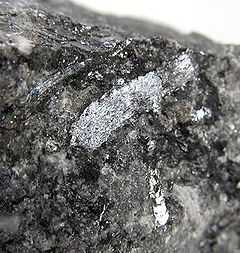Livingstonite
| Livingstonite | |
|---|---|
|
Bright, steel-metallic livingstonite laths to 1.2 cm. on rich antimony (stibnite) ore. From the type locality in Huitzuco de los Figueroa. | |
| General | |
| Category | Sulfosalt mineral |
| Formula (repeating unit) | HgSb4S8 |
| Strunz classification | 02.HA.15 |
| Crystal symmetry | Monoclinic 2/m |
| Unit cell | a = 30.567(6) Å, b = 4.015(1) Å, c = 21.465(3) Å, β = 103.39°; Z=8 |
| Identification | |
| Color | Blackish gray; in polished section, white; red in transmitted light, with deep red internal reflections |
| Crystal habit | As needles elongated [010], to 12 cm; also fibrous, massive, columnar, and in globular masses and interlaced needles. |
| Crystal system | Monoclinic Prismatic |
| Cleavage | Perfect on {001}, poor on {010} and {100} |
| Fracture | Uneven, flat surfaces |
| Tenacity | Flexible |
| Mohs scale hardness | 2 |
| Luster | Adamantine to metallic |
| Streak | Red |
| Diaphaneity | Opaque, translucent in thin fragments |
| Specific gravity | 4.8 - 4.88 meas. 4.98 calc. |
| Optical properties | Biaxial (–) |
| Refractive index | >= 2.72 |
| Pleochroism | Weak; strongly anisotropic |
| References | [1][2][3] |
Livingstonite is a mercury antimony sulfosalt mineral. It occurs in low-temperature hydrothermal veins associated with cinnabar, stibnite, sulfur and gypsum.
It was first described in 1874 for an occurrence in Huitzuco de los Figueroa, Guerrero, Mexico. It was named to honor Scottish explorer of Africa, David Livingstone.
References
- ↑ http://rruff.geo.arizona.edu/doclib/hom/livingstonite.pdf Handbook of Mineralogy
- ↑ http://www.mindat.org/min-2424.html Mindat
- ↑ http://webmineral.com/data/Livingstonite.shtml Webmineral data
- Palache, C., H. Berman, and C. Frondel (1944) Dana’s system of mineralogy, (7th edition), v. I, 485–486
| Wikimedia Commons has media related to Livingstonite. |
